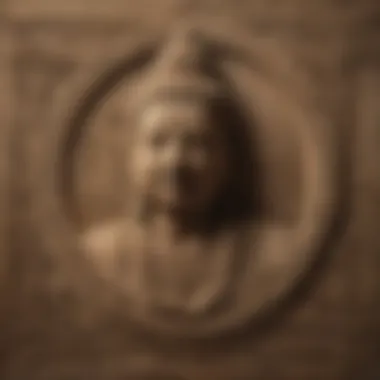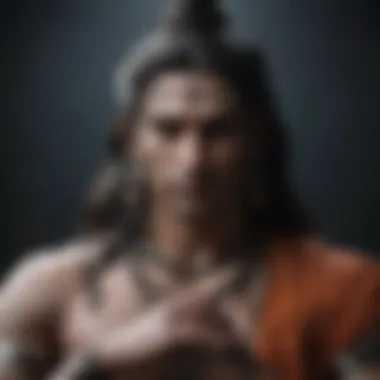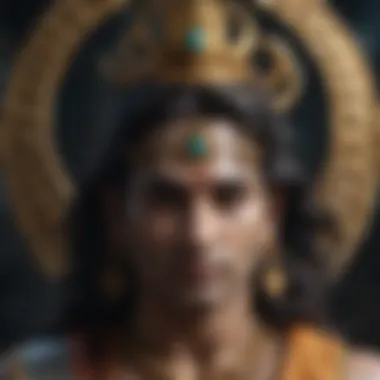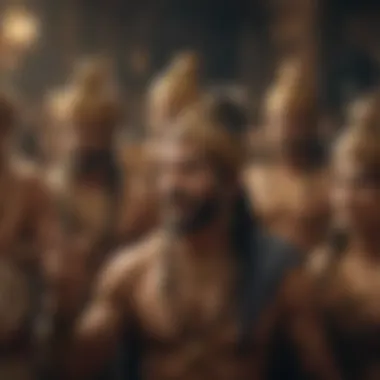Exploring Shiv Tandav Strotra: Significance & Impact


Intro
The Shiv Tandav Strotra is a significant hymn in the context of Hindu spirituality, embodying deep philosophical layers and historical significance. This chant, dedicated to Lord Shiva, has captivated devotees and scholars alike for centuries. Understanding its essence is crucial for those who wish to explore the intricate relationship between spirituality and culture. This section aims to set the stage for a comprehensive analysis of the Strotra, its background, and its ongoing relevance in modern practices.
This article is structured to explore several key dimensions of the Shiv Tandav Strotra:
- Historical origins and context.
- The artistic and lyrical composition of the Strotra.
- Spiritual significance and philosophical insights.
- Cultural impact and contemporary practices.
Through this exploration, readers will gain a nuanced understanding of not just the chant itself but also its place within the larger framework of Hindu traditions and beliefs.
Astrological Concepts
While the focus of this article is primarily on the Shiv Tandav Strotra, understanding the backdrop of astrological concepts provides valuable insight. Astrology has intertwined with Hindu beliefs for centuries, influencing rituals and the daily lives of many practitioners.
Definition of Key Terms
Astrology fundamentally involves the study of celestial bodies and their positions at specific times. Key terms include:
- Zodiac: A belt of the heavens divided into twelve signs, each representing specific traits and influences.
- Horoscope: A chart that depicts the positions of celestial bodies at a particular moment, typically related to an individual's birth.
- Nakshatra: Lunar mansions in Vedic astrology, playing a significant role in determining favorable times for rituals and decisions.
Historical Background of Astrology
Astrology’s roots can be traced back to the Vedic texts, where it was often associated with divine principles. Ancient Indian sages explored the positions of celestial bodies to derive meaning and guidance. Over time, astrology evolved, integrating various cultural influences, which enriched its practice.
Overview of Different Astrology Branches
Astrology is not a monolith; it includes various branches. Each offers a unique perspective:
- Natal Astrology: Focuses on the individual and their birth chart.
- Mundane Astrology: Examines worldly events and their correlations with celestial phenomena.
- Horary Astrology: Seeks answers by interpreting the positions of planets at the time of a specific question.
With this foundational understanding of astrological concepts, we can better appreciate the cultural context from which the Shiv Tandav Strotra emerges and its continuous relevance.
Prolusion to Shiv Tandav Strotra
The Shiv Tandav Strotra holds significant importance in Hindu spirituality and culture. This profound chant, dedicated to Lord Shiva, encapsulates the essence of destruction and creation, serving as a powerful invocation of divine energies. It represents not only a tribute to Shiva's multifaceted nature but also reflects the philosophical depths of Hindu thought. The examination of this chant provides insight into its relevance, historical context, and the rich tapestry of meanings embedded within its verses.
Definition and Overview
The Shiv Tandav Strotra is a Sanskrit hymn composed by Ravana, a character from Indian mythology, known for his devotion to Shiva. The Strotra is an expression of profound reverence and admiration, praising Lord Shiva's attributes and cosmic dance, known as Tandava. In this lyrical piece, language is not merely for communication; it becomes a medium for spiritual elevation and devotion. The Strotra is characterized by its rhythmic cadences and evocative imagery, making it a staple in spiritual practices. By chanting this Strotra, devotees aim to connect with the powerful energies that Shiva embodies.
Historical Background
Historically, the Shiv Tandav Strotra is believed to have origins in ancient Indian texts, woven into the narrative of the Ramayana. Ravana, the demon king, is often depicted as an ardent devotee of Shiva, which adds layers to its historical significance. The Strotra serves as evidence of the interplay between devotion and authority, as Ravana both revered and challenged the divine. Its role in traditional rituals and cultural practices emphasizes its long-standing place in Hindu worship. Over centuries, the Strotra has been recited in various contexts, reinforcing its position in both literature and spirituality. As such, it continues to be an important text for scholars, practitioners, and anyone interested in Hindu spirituality.
The Origin of Shiv Tandav Strotra
The Shiv Tandav Strotra occupies a crucial position in the study of Hindu spirituality and literature. Understanding its origin helps to uncover the deeply rooted traditions and beliefs in Hindu culture. The origin relates directly to the philosophies espoused through the verses, giving insight into Lord Shiva's multifaceted nature.


Mythological Context
In Hindu mythology, the Shiv Tandav Strotra is associated with the cosmic dance of Lord Shiva. This dance symbolizes the cycles of creation, preservation, and destruction. According to legend, Ravana, the king of demons, composed this Strotra in praise of Shiva, aimed at gaining power and devotion. It is said that while Ravana was an ardent devotee, his intentions were initially self-serving, yet his passion and dedication evoked Shiva's grace.
The mythological backdrop illustrates the contrast between the adherents of dharma and the forces of adharma. Ravana’s devotion exemplifies an important point: that even flawed individuals can achieve inner awakening through genuine reverence. Thus, the Strotra serves not only as a hymn but also as a narrative of transformation and redemption.
Textual Sources
The textual sources of the Shiv Tandav Strotra primarily include two ancient works: the Ramayana and certain Puranas. In the Ramayana, the verses are embedded in the context of Ravana's encounter with Shiva. Various Puranas also recount the significance of the Strotra through the lens of rituals performed by devotees.
These ancient texts have been preserved across centuries and allow scholars and practitioners alike to explore the nuances of divine worship. The Strotra itself comprises various verses that extol Shiva's virtues, highlighting his duality as both creator and destroyer. Through these sources, we see how the Shiv Tandav Strotra transcends mere religious text and becomes a means for understanding the human condition through the divine lens.
“The Shiv Tandav Strotra not only serves as a powerful chant, but stands as a testimony to the depth of devotion and ray of transformative power it embodies.”
As we explore further, we will analyze how these origins impact the lyrical composition and philosophical insights of the Strotra, revealing the significance embedded in its verses.
Lyrical Analysis of Shiv Tandav Strotra
The lyrical nature of the Shiv Tandav Strotra offers a critical lens through which to understand its impact and significance. This text can be viewed not only as a prayer but also as a captivating piece of literature that embodies complex ideas and emotions. Its verses speak of creation, destruction, and the duality that characterizes the essence of existence. Examining the structure and composition of its lyrics provides insight into how language shapes spirituality and devotion.
Structure and Composition
The Shiv Tandav Strotra consists of a series of couplets that are rhythmically arranged to evoke a sense of dynamism and power. Each verse is crafted to maintain a specific meter and sound, which enhances its recitative quality. This attention to form is essential as it reinforces the profound meanings embedded within the words. The structure draws from classical Sanskrit poetic traditions, blending aesthetics with sacred intent. Such a meticulous composition invites devotees to engage deeply with the text, encouraging both oral recitation and reflective contemplation.
One noteworthy aspect is the use of alliteration throughout the Strotra. This technique not only creates a melodious flow but also emphasizes specific qualities of Lord Shiva. For example, the repetition of certain sounds can invoke the fierce and transcendent nature of the deity, aligning the worshipper’s energy with the lyrical intensity.
The rhythmic cadence captured in the Strotra is significant as it mirrors the cosmic dance of Lord Shiva himself. Through this structure, the text stands as a dynamic representation of the divine, solidifying the relationship between the reciter and the subject of devotion.
Themes and Imagery
Within the verses of the Shiv Tandav Strotra, various themes emerge, each rich with meaning and implication. One dominant theme is the cyclical nature of existence. The text reflects on creation and destruction, embodying the Hindu philosophy of Samsara. This notion illustrates the perpetual cycle of birth, death, and rebirth, resonating with those who seek to understand their place within the universe.
Imagery also plays a crucial role. Vivid descriptions of Shiva’s cosmic dance, the fierce forms of the deity, and his interactions with the universe are prevalent. Such descriptions serve to elevate the emotional and spiritual experience of the devotee. Instead of abstract concepts, the reader or reciter faces concrete representations of the divine, allowing for a more profound connection.
“The beauty of the Shiv Tandav Strotra lies not just in its composition, but in its ability to convey complex philosophies through simple yet powerful imagery.”
Furthermore, the text invokes feelings of awe and reverence, elements deeply required in spiritual practice. These themes demonstrate the holistic approach of the Strotra in encompassing not merely pious worship, but also an intellectual exploration of the divine relationship.
Philosophical Insights from the Strotra
Understanding the philosophical layers of the Shiv Tandav Strotra is vital to grasp its full significance. This ancient chant radiates knowledge on various existential themes, which can be enlightening for those who engage deeply with it. The insights derived from the Strotra extend beyond mere worship; they provoke thoughts about life's cyclical nature and the dualities inherent in existence. Such explorations aid spiritual seekers, helping them to connect with the profound aspects of life and death, destruction and creation, and divine consciousness.
Understanding Lord Shiva
Lord Shiva, as depicted in the Shiv Tandav Strotra, embodies the essence of both ferocity and tranquility. This duality reflects on a deeper philosophical inquiry into the nature of reality. Shiva represents the endless cycle of existence, known as samsara, which is characterized by creation, preservation, and destruction. In the chant, he is portrayed in various forms—devastating and mesmerizing.
The depiction of Shiva in the Strotra resonates with many seekers, reminding them that life is not only about seeking bliss but also accepting destruction as part of transformation. This realization opens a channel to embrace the nuances of human experience. It serves to highlight how Lord Shiva can be seen not just as a deity, but as a powerful symbol of life's complexities.


The Attributes of Lord Shiva:
- Destroyer: Represents the necessity of destruction in the cycle of creation.
- Meditator: Embodies peace and introspection.
- Cosmic Dancer: Symbolizes the rhythm of life and the universe.
The Concept of Destruction and Creation
The theme of destruction is prominent in the Shiv Tandav Strotra, but it is crucial to interpret it in the context of creation. Destruction, in this philosophical view, is not an end but a precursor to rebirth. It signifies the transitional phase where old forms dissolve to make way for the new. This cyclical nature of existence emphasizes the importance of change.
When destruction occurs, it is often met with resistance. However, according to the philosophic insights from the Strotra, understanding destruction as an integral part of life leads to profound acceptance. The chant teaches practitioners to view challenges and endings as opportunities for renewal.
"Destruction is not merely an end, but a necessary step in the perpetual cycle of existence."
Key Takeaways:
- Interconnection: Destruction and creation coexist in a delicate balance.
- Acceptance: Embracing change is essential for spiritual growth.
- Renewal: Every end gives rise to new beginnings.
Thus, the Shiv Tandav Strotra serves as a philosophical guide. It compels one to reflect on and embrace the complexities of existence, paving the way for deeper spiritual understanding.
Spiritual Significance of the Shiv Tandav Strotra
The Shiv Tandav Strotra holds deep spiritual meaning in Hindu traditions. This ancient chant is more than just a prayer; it is a profound expression of devotion and a vehicle for spiritual elevation. The verses articulate the dynamic nature of Lord Shiva, the god of destruction and transformation, emphasizing the cyclic processes of creation and annihilation. Through this chant, practitioners connect with the essence of Shiva, experiencing a transformative impact on their own spiritual journeys.
Role in Meditation and Rituals
Incorporating the Shiv Tandav Strotra in meditation enhances the depth of the practice. The rhythmic flow of the verses promotes focus and helps transcend mundane thoughts. As devotees recite the Strotra, they can cultivate a sense of peace and tranquility. Many spiritual practitioners suggest that chanting the Strotra can lead to elevated states of consciousness, allowing for direct communion with the divine.
- Chanting as a Form of Meditation: Reciting the Strotra repeatedly centers the mind. This practice aligns the practitioner's energy with that of Lord Shiva.
- Ritualistic Practices: Often, this chant is integrated into pujas (worship rituals). It creates an atmosphere of spirituality, inviting the presence of Shiva.
- Benefits: Regular recitation fosters a sacred environment, invoking protection and fostering inner strength.
Connection to Devotion
The Shiv Tandav Strotra serves as a bridge between the devotee and the divine. In its verses, the fierce and majestic aspects of Lord Shiva are revealed. This portrayal enables devotees to understand and appreciate the complexity of divine emotions.
- Expression of Bhakti: This chant encapsulates deep devotion. It resonates with those who seek to express their love for Lord Shiva.
- Transformative Experience: Listening or chanting the Strotra can shift one's emotional state, creating feelings of devotion and reverence.
- Communal Aspect: Shared recitation during festivals and spiritual gatherings strengthens collective devotion, fostering community ties among practitioners.
In summary, the Shiv Tandav Strotra is not only a spiritual hymn; it is a multifaceted tool that enhances meditation and deepens devotion. Through the act of chanting, individuals connect intimately with the divine essence of Lord Shiva.
Cultural Impacts of the Shiv Tandav Strotra
The Shiv Tandav Strotra has produced significant cultural impacts that resonate with various art forms, literature, and spiritual practices. Its historical roots and lyrical depth contribute to its influence, ensuring its relevance across generations. This section aims to elaborate on how the Strotra shapes cultural expression and unifies diverse practices within Indian society and beyond.
Influence in Art and Literature
The Shir Tandav Strotra has been a prominent source of inspiration for artists and writers throughout history. The themes encapsulated within the Strotra, such as destruction, creation, and the cosmic dance of Lord Shiva, have been interpreted through numerous creative lenses.
Visual Arts: Artists often depict scenes from the Strotra, showcasing the fierceness and beauty of Lord Shiva. Paintings and sculptures reflect an array of interpretations, emphasizing the dynamic aspects of Lord Shiva’s nature. Many traditional paintings capture the essence of the Strotra, translating its rhythmic cadence into visual imagery.
Literature: The Strotra has also found its way into various literary works. Poets and authors have referenced its verses to enrich their narratives. For instance, the vivid descriptions of Lord Shiva’s attributes and his cosmic dance have inspired poetic adaptations and modern retellings. These works often explore the dualities present in the Strotra and its philosophical themes.


Representation in Performing Arts
The impact of the Shiv Tandav Strotra extends into the realm of performing arts as well. Various forms of dance and theatre have incorporated its elements, providing a dynamic platform to express its rich content.
Dance Forms: Numerous classical dance forms such as Bharatanatyam and Kathak frequently feature the Strotra. Choreographers utilize its rhythms to craft performances that embody the essence of Shiva, often interpreting the themes through movements that mirror the Strotra’s lyrical flow. Each gesture and expression in these performances aims to convey the underlying message of creation and destruction that the Strotra embodies.
Theatre: Theatre productions have also embraced the Shiv Tandav Strotra, often integrating specific verses into their scripts. The dramatic enactments of the Strotra can evoke powerful emotions and provoke thoughtful reflections on life and spirituality. This approach allows audiences to connect with the timeless themes presented in the Strotra in a profound manner.
“The Shiv Tandav Strotra resonates in both silence and sound, carrying forward its essence through generations.”
In sum, the cultural impacts of the Shiv Tandav Strotra are far-reaching. Its influence not only shapes artistic expressions but also bridges gaps between literature, dance, and spiritual practices. As society evolves, the Strotra continues to inspire and challenge thinkers, artists, and practitioners, maintaining its place as a cornerstone of cultural heritage.
Modern Adaptations of the Shiv Tandav Strotra
In recent years, the Shiv Tandav Strotra has found new life through various modern adaptations. These adaptations let us consider how ancient texts can resonate with contemporary society. The significance of these interpretations cannot be understated. They breathe new energy into the traditional chants, enabling a wider audience to engage with spiritual practices rooted in Hindu philosophy.
Contemporary Interpretations
Many artists and musicians have taken the Shiv Tandav Strotra and reimagined it through their own unique lenses. For instance, some have fused traditional recitals with contemporary musical styles. This blending not only preserves the original essence of the Strotra but also introduces it to listeners who might not have had exposure to it before. Examples include collaborations with electronic music producers and fusion with genres like rock or pop.
Such adaptations often include themes that resonate with today's environmental concerns. By linking the principles of destruction and regeneration found in the Strotra to modern issues, there’s a deeper connection being established, transcending cultural and temporal boundaries.
In visual arts, painters and digital artists are representing Shiva through modern mediums. This includes creating art that reflects the dynamism and energy associated with the Tandav dance. These artworks serve as a canvas for personal interpretations of Lord Shiva, often showcasing the balance of destruction and creation that is central to the poem. The artistic freedom to interpret the Strotra has led to a resurgence in its popularity and relevance.
Use in Spiritual Practices
The Shiv Tandav Strotra continues to hold significance in spiritual practices today. Its recitation is becoming increasingly common in yoga and meditation sessions. Many practitioners find that chanting the Strotra enhances their connection to spiritual energy and increases focus. The rhythmic quality of the verses lends itself well to setting the tone for meditation, making it a powerful tool for achieving inner peace.
Moreover, various spiritual leaders have incorporated the Shir Tandav Strotra into their teachings. They emphasize its value as a mantra for transformation and healing. By invoking the energy of Lord Shiva, followers seek to align with both the creative and destructive forces present in their lives.
While traditions keep evolving, the Shiv Tandav Strotra remains a significant element of many modern spiritual paths. With a focus on intentional practice and personal experience, these adaptations offer both depth and accessibility to seekers of truth.
The adaptability of the Shiv Tandav Strotra illustrates the timeless relevance of ancient wisdom in contemporary life.
Closure
The conclusion serves as an essential element of this article, synthesizing the various components discussed. It reaffirms the significance of the Shiv Tandav Strotra in both historical and modern contexts. By reviewing its origin, lyrical depth, and cultural impact, the reader gains a multifaceted understanding of this sacred chant.
Recap of Key Insights
The Shiv Tandav Strotra is not merely a religious text but a rich tapestry of philosophy, art, and spirituality. Key insights include the following:
- Historical Context: Its roots trace back to ancient myths, highlighting the narrative of Lord Shiva and his vital role in cosmic balance.
- Lyrical Composition: The Strotra’s sophisticated structure captures the essence of devotion and the dual nature of creation and destruction, compellingly articulating the grandeur of Shiva.
- Philosophical Dimensions: It opens avenues for deeper philosophical inquiry into existence, creating a bridge between the material and the divine.
- Cultural Relevance: The impact of the Strotra extends into various art forms, influencing literature, music, and dance, showcasing its enduring legacy.
Understanding these facets enriches one’s comprehension of not only the text but also the cultural and spiritual landscape of Hinduism.
Encouraging Further Exploration
Encouraging further exploration is critical for deepening one’s relationship with the Shiv Tandav Strotra. Engaging with this chant can provide numerous benefits:
- Personal Growth: Studying its verses may prompt self-reflection and personal development, promoting a deeper connection with the themes of life and death.
- Spiritual Practice: Incorporating the chant into daily rituals can enhance one’s meditation practice, fostering a sense of peace and connection to the divine.
- Cultural Appreciation: Diving into its artistic representations allows for a greater appreciation of how this chant has influenced various forms of creative expression.
“The true essence of spirituality emerges when knowledge transforms into practice.”







